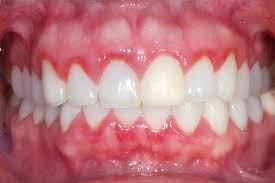Gum disease and how to avoid it
Gum disease, or periodontal disease as is it’s properly termed, is not exactly high profile like heart disease or diabetes since it is not a fatal condition as such. It is, however very common amongst adults and can cause a lot of suffering through gradual loosening and eventual loss of teeth. Although these days you can have replacements in the form of dentures or implants they are never quite the same as natural teeth and have certain disadvantages.
Ideally your teeth and gums should look like this:

and certainly not like this;

which is advanced gum disease with shrinking gums and a build up of calcified tartar.
Gum disease is not much talked about generally because it doesn’t cause much immediate harm but is more a low grade chronic irritation that eventually causes problems.
Gum disease is slowly progressive unless positive action is taken to stop it, but the good news is that, if you establish and maintain an effective oral hygiene habit you can halt or prevent it providing you start early enough.
Our teeth are normally held firmly in their sockets in the jaw bone by a mesh of strong fibres which are called the periodontal membrane, but gum disease slowly destroys these fibres, and then a deepening pocket can form around the tooth allowing food debris to nestle there and more plaque to accumulate, and so the problem gets gradually worse. Eventually the edges of the bone around a tooth start to get resorbed and this leads on to tooth loosening over time.
ou see the cause of gum disease is the sticky mucilaginous film called plaque that forms constantly on our teeth because it contains thousands of bacteria, and some of these release chemicals that irritate and inflame the gums. The inflammation is of such a low level that it it often goes unnoticed. You might see a reddening of the gum margins or experience some bleeding of the gums when you brush your teeth. If you see blood then, unless you’re using a really hard toothbrush or brushing too hard the wrong way, then it is a sign of inflammation. At this early stage the problem can be overcome by very carefully removing all the plaque on all surfaces of all teeth every single day.This way you keep down the numbers of bacteria in the mouth and they never get a chance to proliferate and cause disease.
Early gum disease can look like this:

A condition called gingivitis, a condition where the gums are inflamed but noticeable pockets have not yet developed and the gum has not appreciably shrunk back as yet. At this stage of early gum disease careful attention to oral hygiene will halt its progress and return the gums to a normal appearance.
This is straightforward in theory but not always quite so easy in practice since many people clean their teeth without giving it any conscious thought or effort and so often this is quite inefficient.
It is necessary to look in the mirror when cleaning your teeth to make sure you are cleaning front and back of each and every tooth. Start at one end of the upper or lower arch of teeth and gradually work your way around with brush strokes up from the gum edge and towards the biting edge of the teeth. The brush should be angled at approximately 45 degrees to the teeth surfaces and you should use short sharp strokes. A few wiggling sideways strokes can be used first to dislodge debris but avoid long horizontal strokes across the front of the teeth because this gradually wears away enamel and the teeth can become sensitive.
As you can imagine, to do this properly can take a few minutes and this is the other problem – that people rarely spend enough time on their oral hygiene.
There is also hidden plaque on the sides of the teeth which is of course difficult to reach because one tooth is usually bang up against the next. So to remove this you need to use dental floss which is a thin strong cotton or synthetic thread, sometimes waxed; and you need to slide this between the teeth and move it from the gum edge away towards the biting edge whilst holding it tight against the tooth surface. The aim is to move that plaque up and away, but it requires a deft hand and the patience to go between each and every tooth. If you’re unsure about the proper flossing technique you can ask your dentist to show you.
It can be difficult to know whether you have satisfactorily removed all plaque or not but there is way to stain the plaque to make it show up. You can buy some disclosing tablets which are made from a harmless vegetable dye. Chew one up before cleaning your teeth and it will clearly colour the plaque, usually red or blue, and then you can actually see when you have successfully removed that plaque.
All this may seem time consuming and boring but regular plaque removal is the only way to keep your gums healthy and avoid problems such as bad breath, tartar formation, and ultimate loosening of teeth. It is worth making time for...if you want a pleasant and attractive smile...
